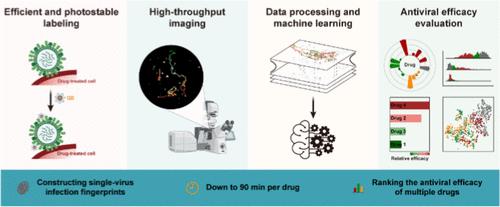Rapid Deployment of Antiviral Drugs Using Single-Virus Tracking and Machine Learning
IF 15.8
1区 材料科学
Q1 CHEMISTRY, MULTIDISCIPLINARY
引用次数: 0
Abstract
The outbreak of emerging acute viral diseases urgently requires the acceleration of specialized antiviral drug development, thus widely adopting phenotypic screening as a strategy for drug repurposing in antiviral research. However, traditional phenotypic screening methods typically require several days of experimental cycles and lack visual confirmation of a drug’s ability to inhibit viral infection. Here, we report a robust method that utilizes quantum-dot-based single-virus tracking and machine learning to generate unique single-virus infection fingerprint data from viral trajectories and detect the dynamic changes in viral movement following drug administration. Our findings demonstrated that this approach can successfully identify viral infection patterns at various infection phases and predict antiviral drug efficacy through machine learning within 90 min. This method provides valuable support for assessing the efficacy of antiviral drugs and offers promising applications for responding to future outbreaks of emerging viruses.

使用单病毒跟踪和机器学习快速部署抗病毒药物
新发急性病毒性疾病的爆发迫切需要加快抗病毒药物的专门化开发,因此在抗病毒研究中广泛采用表型筛选作为药物改用的策略。然而,传统的表型筛选方法通常需要数天的实验周期,并且缺乏对药物抑制病毒感染能力的视觉证实。在这里,我们报告了一种鲁棒的方法,利用基于量子点的单病毒跟踪和机器学习,从病毒轨迹中生成独特的单病毒感染指纹数据,并检测药物给药后病毒运动的动态变化。我们的研究结果表明,该方法可以在90分钟内成功识别不同感染阶段的病毒感染模式,并通过机器学习预测抗病毒药物的疗效。该方法为评估抗病毒药物的疗效提供了有价值的支持,并为应对未来新兴病毒的爆发提供了有希望的应用。
本文章由计算机程序翻译,如有差异,请以英文原文为准。
求助全文
约1分钟内获得全文
求助全文
来源期刊

ACS Nano
工程技术-材料科学:综合
CiteScore
26.00
自引率
4.10%
发文量
1627
审稿时长
1.7 months
期刊介绍:
ACS Nano, published monthly, serves as an international forum for comprehensive articles on nanoscience and nanotechnology research at the intersections of chemistry, biology, materials science, physics, and engineering. The journal fosters communication among scientists in these communities, facilitating collaboration, new research opportunities, and advancements through discoveries. ACS Nano covers synthesis, assembly, characterization, theory, and simulation of nanostructures, nanobiotechnology, nanofabrication, methods and tools for nanoscience and nanotechnology, and self- and directed-assembly. Alongside original research articles, it offers thorough reviews, perspectives on cutting-edge research, and discussions envisioning the future of nanoscience and nanotechnology.
文献相关原料
公司名称
产品信息
索莱宝
bovine serum albumin (BSA)
索莱宝
bovine serum albumin
 求助内容:
求助内容: 应助结果提醒方式:
应助结果提醒方式:


